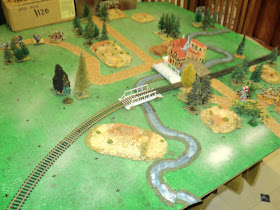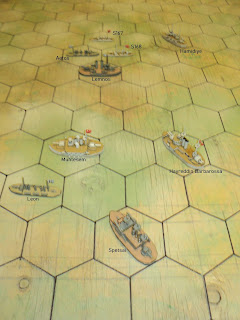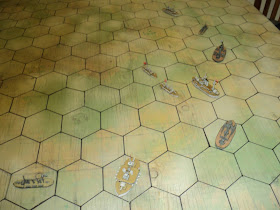A week after breaking out from the Dardanelles Strait, the protected cruiser TNS Hamidiye was lurking far to the south in the open Mesogesean Sea, and heading further south, past the small island of Kassos. As luck would have it - there seemed no other explanation for the fortuitous encounter - as the Hamidiye came clear of the island, its lookouts at once spied, at no great distance to the southeast where it had been previously masked by the island, a small Hellenic convoy, heading due west. Obviously those ships would soon have altered course to pass through the strait between Kassos and Creta, thence on to Piraefs, the port of Athenae.

It was 'Helm aport!' at once aboard the
Hamidiye. The convoy comprised four vessels, the armed merchant cruiser
SS Iphaisteio, and 3 unarmed merchantmen. Slow as these lumbering vessels were, there was little hope in outrunning the faster light cruiser. Commanding the convoy aboard
Iphaisteio, Commander Yiannis Xiphias at once ordered the convoy to alter course to the south, and, steering his own vessel such as to bring his broadside guns within range, made for the rapidly closing enemy.
This was something of an indulgence: I simply wanted to 'do' a
HMS Jervis Bay type of action. To be sure, it could go but one way, but what the hang, eh? As it happens, Paul Jackson had stopped by to have a look at my newly acquired
Turing Tumble toy (a birthday present six weeks early), and I thought I'd rope him in to the action commanding the commerce raider.
Here are the Stats;
Turcowaz: Captain Rauf Orbay:
Speed: 3 hex maximum.
Commander Yannis Xiphias:
SS Iphaesteio Flotation 6/1 Main Broadside 3 2 2 1 x
Main Fore/Aft 1 1 1 1 x
2-dary B/side 1 1 1 1 x
SS Ithaca Flotation 6/1 Unarmed
SS Skythios Flotation 4/1 Unarmed
SS Lefkada Flotation 4/1 Unarmed
(I had the EXCEL file copied in fine, but, discovering a slight error, corrected the file, then tried to replace with the correction. Of course it wouldn't 'take'. What did I expect?)
In a change to the original Gridded Naval Wargames I made all merchant vessels' speed 2-hexes maximum. I figured that if they could match the raiders' speed, the chances of their escape were just too high. I also decreed that a vessel whose Flotation Points (Value) had been reduced to 0, was not sunk, but became salvageable, perhaps, given time, by its own crew.
I actually made one other change - actually a mistake - but I'm inclined to think not an unreasonable one.
The encounter occurring about early to mid-afternoon, I gave the raider 15 turns to do whatever damage he could

So to the action: SS Iphaisteio at once took on the enemy raider. As the range rapidly closed, the Hellenic vessel altered course to the southwest to bring both its main and secondary broadsides to bear at maximum range. She even got off the first salvo, but without effect. As it transpired that was her last. Hamidiye's immediate reply started fires along the main deck, but, more seriously opened a large hole along the waterline. Winning the initiative thereafter, Hamidiye's next salvo effectively knocked out the forward gun turret, and two more hits left the escort cruiser dead in the water, a flaming wreck.

Of course, I ought to have allowed Iphaisteio a last salvo, and a lucky hit might have done enough damage to permit the convoy to scatter and get away. At any rate, her fight was over, now. Hamidiye might have stayed a few minutes longer to finish the job, but instead at once set off due south to haul in SS Ithaca. That vessel hadn't got very far, and Hamidiye rapidly closed the range to point blank. Two salvoes were enough to send the merchant ship to the bottom.
By this time, the smaller merchant ships had made off to the southeast. SS Skiathos was also soon overhauled. Making its best speed past that vessel Hamidiye sent in a couple of salvoes that also reduced Skiathos into a flaming raft. The raider then set off after the single remaining vessel of the convoy. Narrowing the distance to about medium range, Hamidiye sent after the fleeing SS Lefkados a salvo that scored a minor hit somewhere aft.
By this time, the afternoon was far advanced - perhaps 9 or more turns having passed by. The sun beginning to fade behind the Mesogesean early evening haze, Captain Rauf Orbay chose to retrace its steps and finish off the floating wrecks left behind. At his approach, the crew of Skiathos hastily took to their lifeboats, whereat a single salvo finished off the vessel.
Then came the long haul back to the flaming Iphaisteio. That vessel died hard. In the gathering twilight, the flames might have helped the raider's aim. But it was to take three salvoes, the last at point blank range, finally to sink the gallant escort cruiser.
By then, of course, SS Lefkados had got clean away to the open sea and into the night. Captain Rauf Orbay declined to order a pursuit, but himself took his ship southward, away from the islands, after which he planned a short visit to the Peloponnesos. The sinking of three quarters of a convoy, and damaging the rest, would look well on his report to the Admiralty...
Well, perhaps not the most exciting naval action, and getting the lumbering merchant ships to scatter turned out to be a deal harder than I thought, but had Turcowaz naval gunnery aboard Hamidiye been less formidable early on (in one salvo, he rolled 3 'sixes' for hits), maybe one more vessel could have escaped.
For his part, Paul was so enthused by the action, that he resolved to build a small navy of his own. Last Tuesday evening, whilst I added two more torpedo boat/ destroyers to each of my Hellenic (Leon and Aetos) and Turcowaz (S167 Numune and S168 Gayret) fleets, and made a start of a second Hydra class vessel, Paul put together a small freighter, and a destroyer-sized warship that might stand for destroyer, armed trawler or perhaps a minelayer/ minesweeper.
Something about the rule set.
I'll take the time here to discuss something about the original Gridded Naval Wargames 'Pre-Dreadnought' rules, in particular how Flotation Points (FPs) are assigned. The author, Bob Cordery, determined the FP by type of vessel. Quite arbitrary, but perfectly reasonable. However, I noticed a considerable disparity of weight between coastal battleships Hydra and Mesudiye, even though their dimensions of length and beam were fairly comparable, and their designations - coastal defence battleship - the same.
It seems Mesudiye displaced roughly double the tonnage of Hydra. Now, I have in a different (simple) rule set, determined that FP might be geared to displacement, some of that weight assumed to be going towards armour. But the method I used for that 'other' rule set simply wouldn't work here. After a deal of playing around with numbers I came up with this:
FP = √W
5
Where W is the tonnage of the vessel. Yes, this is quite arbitrary, but, the result, rounded, is designed to accommodate the size of vessels from, say, 500 tons (or even less) to well over 10,000. It seems to 'fit' pretty well.
The outcome is to increase the FP slightly for the larger ships, but let us see what it looks like for my Blacklands War navies:
Hellenic:
Lemnos - modern pre-Dreadnought. Tonnage = 13,000 FP = 23 CP = 6
Georgios Averof - armoured cruiser. Tonnage = 10,000 FP = 20 CP = 5
Hydra - coastal battleship. Tonnage = 4000 FP = 13 CP = 3
Panthir Class - destroyer. Tonnage = 880 FP = 6 CP = 1.
Turcowaz:
Turgut Reis - older pre-Dreadnought. Tonnage = 10,000 FP = 20 CP = 5
Mesudiye - coastal battleship. Tonnage = 9000 FP = 19 CP = 4
Hamidiye - protected cruiser. Tonnage = 4000 FP = 13 CP = 3
Muavenet - class - destroyer. Tonnage = 700 FP = 5 CP = 1.
At the moment, the Turcowaz fleet looks the more powerful, but the addition of a second 'Hydra' (call it Psara) will go to equalising them.
I have yet to test this suggested system. That might have to wait for a 'Second Blacklands War'...




















































